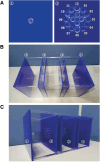Evaluation of a 12-hole clock model for improving bronchoscopic skills in simulated normal and difficult airways among anesthesia residents: A randomized controlled study
- PMID: 38847658
- PMCID: PMC11155588
- DOI: 10.1097/MD.0000000000038510
Evaluation of a 12-hole clock model for improving bronchoscopic skills in simulated normal and difficult airways among anesthesia residents: A randomized controlled study
Abstract
Background: Simulation-based training is used to improve fiberoptic bronchoscopic skills for novices. We developed a nonanatomical task trainer (named 12-hole clock model) that focused on training manipulation of bronchoscopes. The aim of this study was to evaluate the training effect of this model on bronchoscopic skills and learning interests in simulated normal and difficult airways among anesthesia residents.
Methods: Forty-three anesthesia residents without experience in bronchoscopic intubation were randomly divided into control (n = 22) and intervention groups (n = 21). All participants received standard multimedia learning and a baseline test using a normal airway manikin. Then, the control and intervention groups engaged in 60 minutes of training via a traditional airway manikin or the clock model, respectively. After training, the participants completed bronchoscopic performance assessments in simulated normal and difficult airways, as well as an electronic questionnaire related to the course.
Results: During training, the total hands-on time of bronchoscopic practice recorded by trainees' themselves was longer in the intervention group than in the control group (1568 ± 478 seconds vs 497 ± 172 s, P < .0001). Posttraining, the time required to visualize the carina in simulated normal airways was longer in the intervention group than in the control group (22.0 [18.0, 29.0] vs 14.0 [10.8, 18.3], P < .0001), while it was shorter for simulated difficult airways (24.0 [16.0, 32.0] s vs 27.0 [21.0, 35.5] s, P = .0425). The survey results indicated that confidence in bronchoscopic intubation increased in both groups, without significant differences in satisfaction, acceptance, or perceived difficulty between the groups. However, the interest ratings were higher in the intervention group than in the control group.
Conclusions: The 12-hole clock model is a simple and feasible method for improving bronchoscopic skills and promoting interest among trainees.
Trial registration: NCT05327842 at Clinicaltrials.gov.
Copyright © 2024 the Author(s). Published by Wolters Kluwer Health, Inc.
Conflict of interest statement
The authors have no conflicts of interest to disclose.
Figures



Similar articles
-
[Comparison of five video laryngoscopes and conventional direct laryngoscopy : Investigations on simple and simulated difficult airways on the intubation trainer].Anaesthesist. 2015 Jul;64(7):513-9. doi: 10.1007/s00101-015-0051-5. Epub 2015 Jul 15. Anaesthesist. 2015. PMID: 26174747 German.
-
The effect of virtual reality bronchoscopy simulator training on performance of bronchoscopic-guided intubation in patients: A randomised controlled trial.Eur J Anaesthesiol. 2019 Mar;36(3):227-233. doi: 10.1097/EJA.0000000000000890. Eur J Anaesthesiol. 2019. PMID: 30234669 Clinical Trial.
-
Intubation through 2 supraglottic airway device in cervical spine immobilization: a randomized trial of residents' use of the intubating laryngeal mask airway and the intubating laryngeal tube in manikins.Emergencias. 2018 Jun;30(3):186-189. Emergencias. 2018. PMID: 29687674 Clinical Trial. English, Spanish.
-
Awake supraglottic airway guided flexible bronchoscopic intubation in patients with anticipated difficult airways: a case series and narrative review.Korean J Anesthesiol. 2019 Dec;72(6):548-557. doi: 10.4097/kja.19318. Epub 2019 Sep 2. Korean J Anesthesiol. 2019. PMID: 31475506 Free PMC article. Review.
-
A Primer on Simulation-Based Training in Anesthesia Residency.Int Anesthesiol Clin. 2024 Jul 1;62(3):55-63. doi: 10.1097/AIA.0000000000000446. Epub 2024 May 24. Int Anesthesiol Clin. 2024. PMID: 38785159 Review. No abstract available.
References
-
- Collins SR, Blank RS. Fiberoptic intubation: an overview and update. Respir Care. 2014;59:865–78 [discussion 878]. - PubMed
-
- Apfelbaum JL, Hagberg CA, Connis RT, et al. . 2022 American society of anesthesiologists practice guidelines for management of the difficult airway. Anesthesiology. 2022;136:31–81. - PubMed
-
- Jepsen CH, Gatke MR, Thogersen B, et al. . Tracheal intubation with a flexible fibreoptic scope or the McGrath videolaryngoscope in simulated difficult airway scenarios: a randomised controlled manikin study. Eur J Anaesthesiol. 2014;31:131–6. - PubMed
-
- Higham H, Baxendale B. To err is human: use of simulation to enhance training and patient safety in anaesthesia. Br J Anaesth. 2017;119:i106–14. - PubMed
Publication types
MeSH terms
Associated data
LinkOut - more resources
Full Text Sources
Medical

